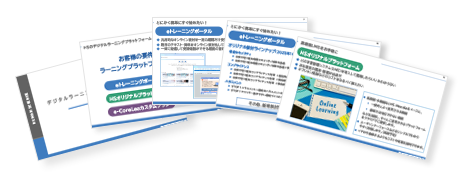2025.05.01
Improve Efficiency with iSpring Suite MAX's Text-to-Speech Feature!

The e-learning content creation tool "iSpring Suite MAX" includes a feature to generate AI voices. This convenient function creates speech from input text, which can be used for narration and more. ※
It supports over 50 languages and offers multiple voice types for reading aloud, allowing you to choose according to your needs and preferences.
This time, we will introduce the speech synthesis feature of iSpring Suite MAX, which enables efficient narration creation.
*This feature is not available in iSpring Suite.
1. Narration Essential for Rich Content
E-learning materials with narration are generally especially effective when the learning content is complex or difficult, or when learners' motivation to study is not very high.
This format involves watching animations or videos on the screen while listening to narration that explains the situation, creating a state similar to listening to an instructor's explanation.
Content that uses narration, animation, or video, as opposed to simple content composed only of text and still images, is sometimes called "rich content."
By enriching the content, it is possible to motivate learning and provide clear explanations.
<Deciding Whether to Include Narration at the Design Stage>
When designing e-learning materials, the first decisions are the "target audience" and the "learning objectives." In other words, you decide who the materials are for and what you want them to achieve. By setting this as the basic policy and then determining the specifications and expressions accordingly, we aim to create materials without contradictions or deficiencies.
Whether to include narration is also decided during the planning and design phase. This affects not only the workload and cost but also has a significant impact on scenario creation.
<How to Create Narration Audio>
There are several options for creating narration audio.
> Request recording from a pronarrator
> Record the instructor's explanation
> Record the voice of the teaching material producer
> Create AI voice
Let's take a look at each method.
●Request Recording from a Professional Narrator
This method involves having a professional narrator or voice actor read the narration script created for educational materials and using the recorded audio.
The greatest advantage is obtaining output that perfectly matches the creator's requests regarding voice quality, speed, pauses, tone, and more. Not only narration but also character lines can be performed with rich emotion.
Additionally, industry-specific terms and specialized vocabulary used within the company can be read aloud with intonation familiar to the learners.
Points to note include the following:
6 Using a recording studio will incur additional costs
7 Scheduling adjustments are required for the narrator, studio, and post-recording editing process
8 Additional costs will be necessary if corrections or additions occur after recording
●Record the Instructor's Explanation
This method involves having the instructor of the teaching material provide the narration. Since the instructor is well-versed in the content, it is advantageous to entrust them with the scenario creation process and have a professional in the learning theme explain the material clearly. If the instructor usually conducts group training sessions, smooth recording can also be expected.
In addition to audio-only recording, there is also a method of video recording the instructor's explanation and combining it with PowerPoint files or other materials to create the teaching content.
The following points should be noted. However, these may not be necessary if the instructor is within the company.
6 Recording equipment and facilities need to be considered
6 Confirmation of rights, usage period, etc. is required
6 Schedule adjustments are necessary
6 Additional costs will be required if corrections or additions occur after recording
●Record the voices of the instructional material creators
This method involves the person in charge of creating the instructional materials doing the narration. The script needs to be prepared in advance.
Since the person in charge records the narration themselves during the production process, scheduling adjustments with various stakeholders for narration recording become simpler or unnecessary.
For recording, using your own equipment such as a PC with a microphone or a smartphone allows for more efficient progress and flexible handling of corrections and additions.
The points to note are as follows:
・Consideration of recording equipment and facilities is necessary
・There is a high possibility of many NG takes, which may take time
・It is difficult to maintain a consistent voice quality and reading pace, which may result in hard-to-understand narration
●Create AI Voice
This method uses a tool that performs text-to-speech to generate AI voice. You need to prepare a script in advance.
Since the voice file is generated simply by inputting text, it can keep up with the production pace.
Also, since no recording equipment is needed, the biggest advantage is that you can create voice just with a computer.
The points to note are as follows:
・There may be cases where specialized or technical terms are not read as intended
・There are limitations, such as tools that cannot adjust intonation or require a long time for adjustments
・Emotional expressions are often difficult, making it hard to use for character dialogue
・Since additions and corrections are flexible, if narration is re-recorded multiple times, the workload may increase
As an additional use of AI voice, it can also be used as a "temporary narration." Even if the final narration uses a professional narrator's voice, using temporary narration makes it easier to identify issues in advance. By listening to the narration while watching the actual movements on the screen, you can make appropriate adjustments before recording the final narration, allowing you to proceed with a more polished script during the recording.
To generate AI voice, a dedicated tool is required, but with iSpring Suite MAX, the AI voice generation feature is already provided.
From the next chapter, we will explain the speech synthesis feature of iSpring Suite MAX.
2. What is the "Text-to-Speech" feature of iSpring Suite MAX?
●What is iSpring Suite MAX?
iSpring Suite MAX is e-learning content creation software developed by the US company iSpring. Once installed, a tab is added to the PowerPoint ribbon, allowing it to be used like bundled software within PowerPoint.

Based on PowerPoint's features, functions for creating e-learning materials have been enhanced or added, allowing you to efficiently create e-learning content using a familiar interface.
You can also create quizzes and simulation content, and since icons and illustrations are provided, it is possible to handle the entire process of material production by yourself.
You can also choose the format in which to generate e-learning materials. Select either HTML5 format or video format.
Additionally, it can be made compliant with SCORM.
>Creation of e-Learning Materials ~Key Points for SCORM Conversion After Creating PowerPoint Files~
●iSpring Suite MAX "Text-to-Speech" Feature
To generate AI voice with iSpring Suite MAX, launch the tool "iSpring Narration Editor" from the iSpring tab added to PowerPoint.
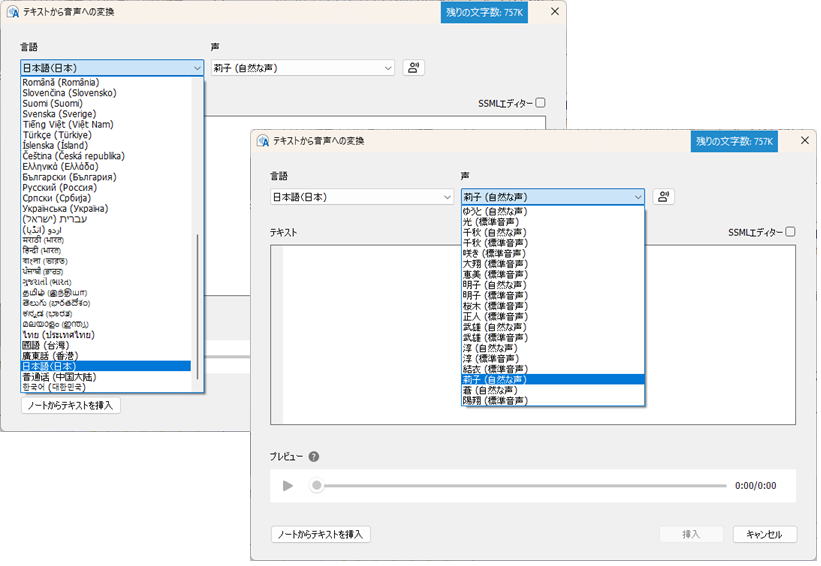
This is the screen for generating audio.
You can select the language and the voice (narrator).
The generated narration can be edited on this screen and modified at any time.
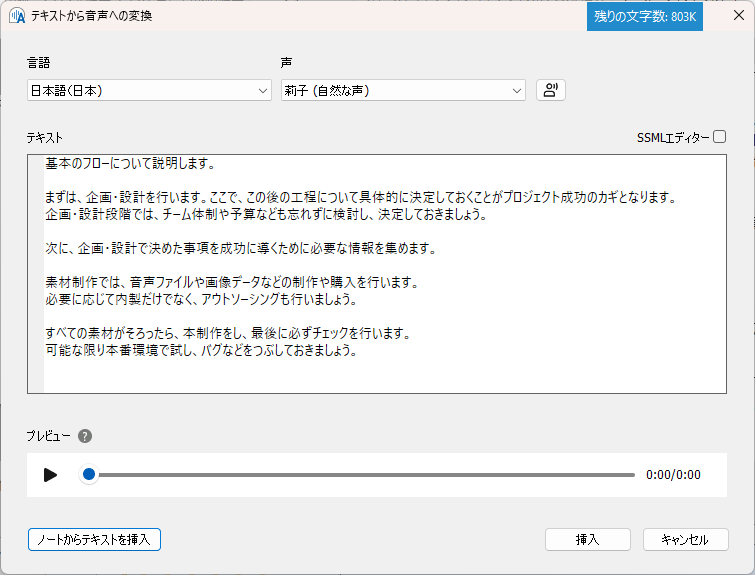
3. Specifications of the Text-to-Speech Feature in iSpring Suite MAX
From here, we will introduce specific functions and operations.
The steps to generate and save an audio file from a PowerPoint file are as follows.
1. Prepare the PowerPoint file
2. Open iSpring Narration Editor
3. Select the insertion point
4. Choose the language and voice (narrator)
5. Enter the text
6. Insert the generated narration
7. Synchronize as needed
8. Save and close
<1. Prepare the PowerPoint file>
Prepare the PowerPoint file in advance.
First, create the narration script and write it in the "Notes" section. This step is not mandatory, but since iSpring Narration Editor has a feature to import text written in the "Notes," it is recommended to use this for record-keeping and review purposes, especially when making corrections later.
Also, if you want to add animation effects to the slides and synchronize them with the narration, set the animation effects in the order that matches the narration.
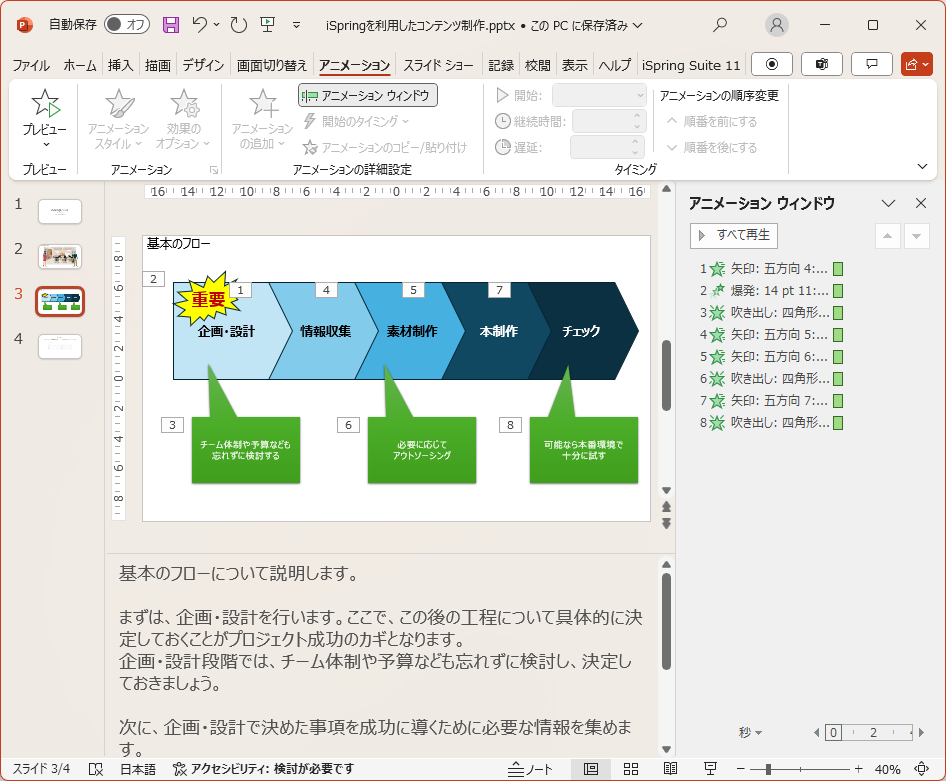
<2. Open iSpring Narration Editor>
From the iSpring tab, select "Manage Narration" to launch the tool "iSpring Narration Editor."

It will be displayed as a separate window from PowerPoint, but while the "iSpring Narration Editor" is open, you cannot edit the PowerPoint file.
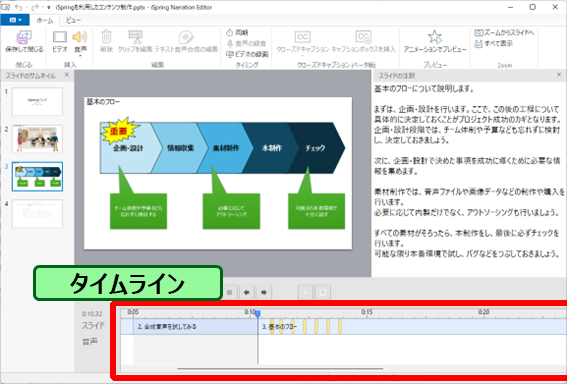
A timeline is displayed at the bottom of the screen, divided by each slide.
The narration you create will be shown on this timeline.
<3. Select the insertion point>
Select the point where you want to insert the narration.
If you want to start the narration from the beginning of the slide, click any position on the timeline of the corresponding slide.
If you want to insert narration in the middle of a slide, click the point where you want the narration to start.
Multiple audio files can be inserted into a single slide.
For example, narration can be created with iSpring Suite MAX, and character lines can be recorded by a professional narrator, allowing audio files to be inserted in sequence so that the lines play after the narration.
However, since multiple audio tracks cannot be layered on the timeline, it is not possible to play background music while the narration is playing.
<4. Select Language and Voice (Narrator)>
Select "Speech" then "Text-to-Speech".
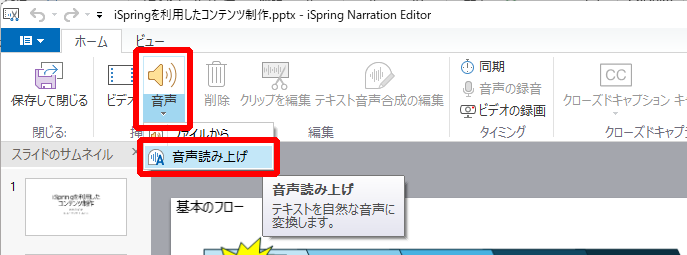
Select the "Language" and "Voice".
You can also listen to a sample voice by clicking the icon to the right of "Voice".

<5. Enter Text>
Enter the text to be read aloud, or select "Insert Text from Notes" to insert text.
You can check the reading aloud in the "Preview".
By using the "SSML Editor," you can intentionally insert pauses and adjust the reading speed.
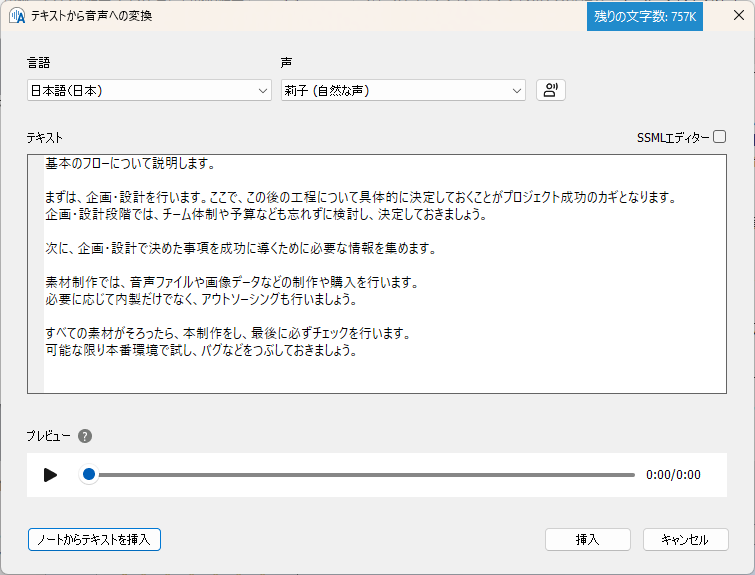
<6. Insert the generated narration>
By selecting "Insert," you can specify the insertion method.
Selecting "Current Cursor Position" inserts narration at the cursor's position on the timeline.
However, after insertion, you can move the position on the timeline.
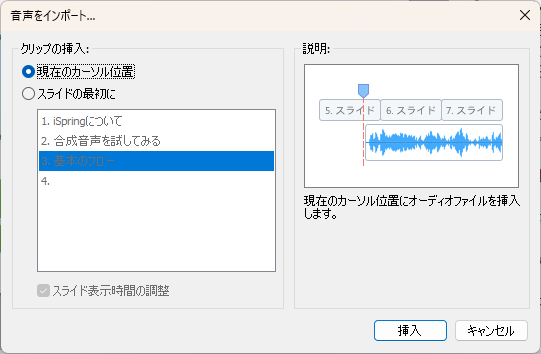
Selecting "At the beginning of the slide" inserts narration so that playback starts from the beginning of the slide where the cursor is displayed on the timeline.
Also, when "At the beginning of the slide" is selected, you can toggle the checkbox "Adjust slide display time" at the bottom left ON or OFF. When ON, the length of the slide timeline is adjusted to match the length of the inserted narration.
When "At the current cursor position" is selected, this checkbox cannot be selected, so you need to adjust the timeline manually.
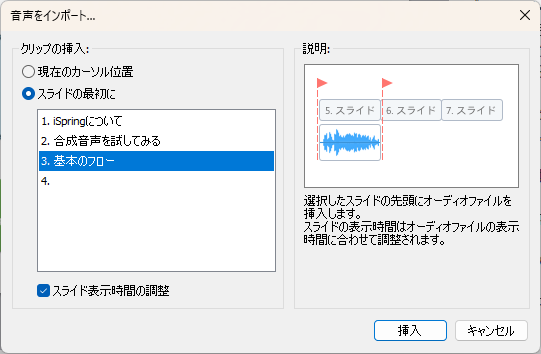
<7. Synchronize as needed>
If an animation is set on the slide, the timing of the animation is displayed on the timeline as a yellow slide bar.
The slide bar can be dragged left and right, allowing you to adjust and synchronize it with the audio timing as needed.
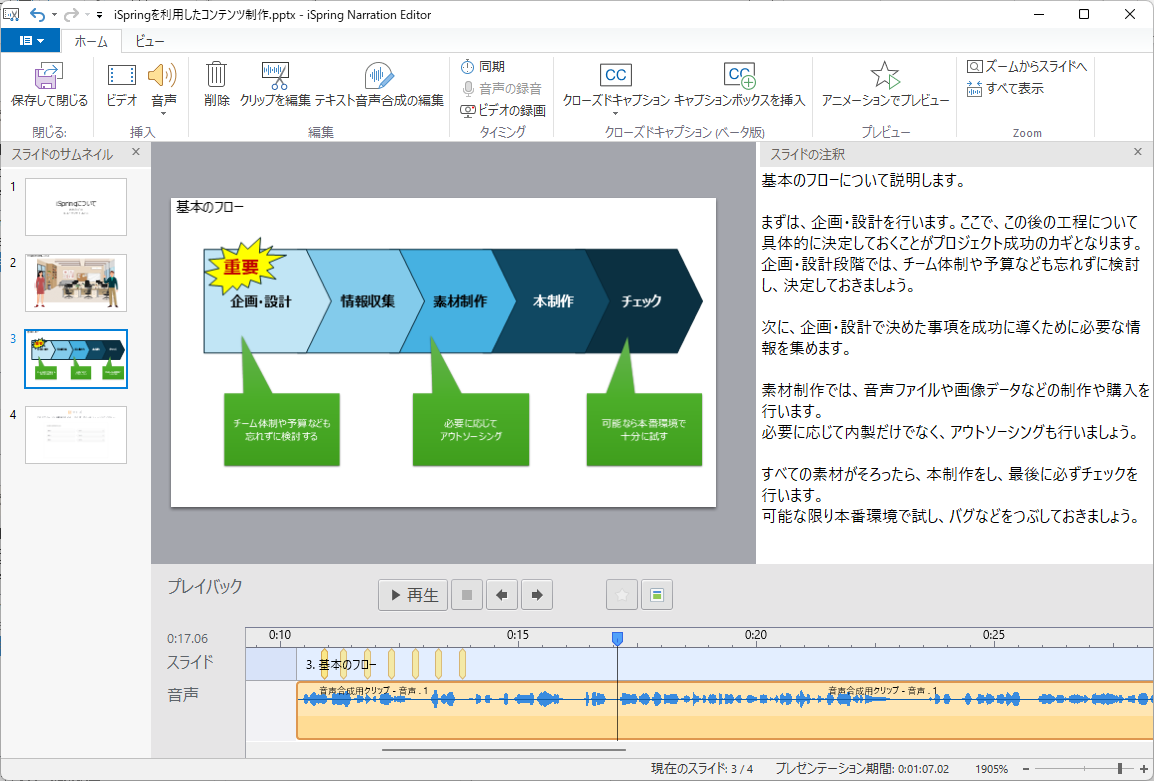
<8. Save and Close>
After all tasks are completed, return to the PowerPoint file.
Select "Save and Close".
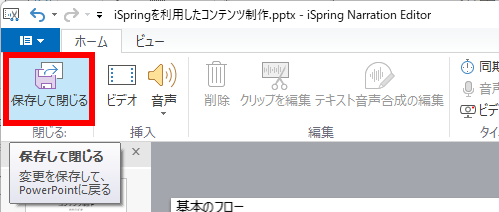
If you close without saving, all work done in iSpring Narration Editor, such as created narrations, will be discarded, so please be careful.
You can also save the file during work without returning to PowerPoint.
Select "Save" from the leftmost tab.
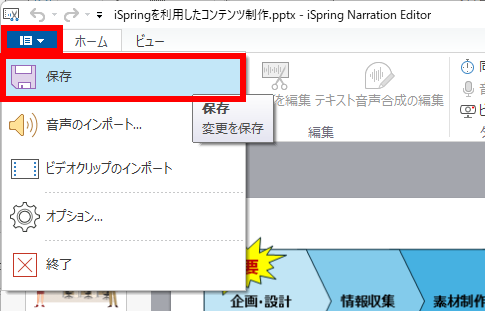
If there are many slides and the work takes a long time, or if you need to step away during the process, we recommend saving your work regularly.
4. How to Utilize the Text-to-Speech Feature of iSpring Suite MAX
The text-to-speech feature in iSpring Suite MAX can be used not only as narration data for educational materials but also as a temporary narration to improve the quality of the materials.
What other ways can it be utilized?
First, since we support more than 50 languages, you can create foreign language narration without having to search for a narrator for each language.
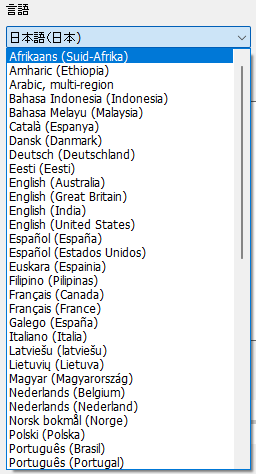
Translation texts need to be prepared.
By utilizing this feature, you can provide rich content with narration in multiple languages to foreign staff and others.
It can also be used together with subtitles.
Text written in the "Notes" section of PowerPoint files can also be displayed in the content.
In particular, displaying subtitles can supplement content that is difficult to understand by narration alone, and it enables consideration for learning environments where sound cannot be used.

5. Summary
So far, we have explained the text-to-speech feature of iSpring Suite MAX. How did you find it?
As a reminder, the presence or absence of narration significantly affects not only costs and processes but also scenario creation. For efficient development, we recommend considering this during the design phase.
The narration method also has its own strengths and weaknesses, so please consider it according to your budget and schedule.
At Human Science, we offer various services including sales, implementation support, and production outsourcing for iSpring products.
This time, we focused on the speech synthesis feature, but there are many other useful functions as well.
If you are interested or considering implementation, please feel free to contact us.
Also, we would appreciate it if you could refer to Human Science Inc.'s e-learning site.
>Create rich e-learning materials with your familiar PowerPoint - iSpring implementation support
>Support for iSpring product implementation and content creation outsourcing
Understand the features and usage of iSpring Suite / iSpring MAX!Complete Guide to iSpring
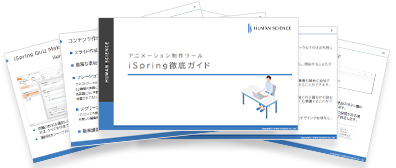
This section introduces the overview and usage of the animation teaching material production tool "iSpring."
This book provides a complete understanding of iSpring. You will also have an image of the teaching material production after implementation.
【Contents】
- What is iSpring Suite / iSpring Suite MAX
- How to create teaching materials using iSpring Suite / iSpring Suite MAX
- Overview and Utilization of iSpring Suite (MAX)
- Features of iSpring Suite (MAX)
- Specific Usage of iSpring Suite (MAX)
- iSpring Suite (MAX) Certified Reseller
- Introduction to Human Science












